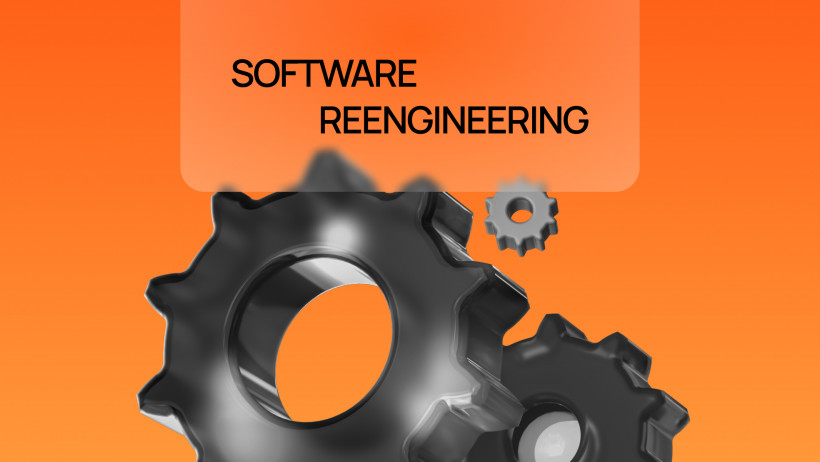You’ve probably heard horror stories of companies spending months, sometimes years, on a full rebuild of their outdated systems. Budgets spiral out of control, deadlines stretch endlessly, and the “new” software sometimes can’t even match the proven reliability of the old one.
But here’s the truth: full rebuild ≠ the only option. For many businesses, there’s a smarter, safer, and more cost-effective way to modernize — software reengineering.
Instead of throwing everything away, application modernization focuses on reviving your legacy systems. It keeps the business logic you’ve invested in for years, while improving the code quality, updating the architecture, and boosting performance. This approach blends the software modernization process with risk mitigation strategies, giving you modern capabilities without a disruptive restart.
What Is Software Reengineering?
At its core, application transformation is about analyzing, restructuring, and upgrading existing systems to boost maintainability, scalability, and performance without starting from scratch. Unlike a simple legacy upgrade, reengineering takes a holistic view, pinpointing where changes will deliver the biggest impact.
The approach emerged when organizations saw that many legacy systems still held immense value: years of fine-tuned business rules, industry workflows, and integrations that are costly and risky to replace. Through reverse engineering, architecture restructuring, and targeted enhancements, outdated tools can be transformed into modern, secure, and scalable systems.
For example, a legacy warehouse app can be reengineered to run on a modern framework, clean up obsolete code, and add APIs — all while preserving its proven inventory logic. The result? Faster performance, easier maintenance, and room for growth, delivered in a fraction of the time a full rebuild would require.
Ultimately, software modernization is a strategic choice: keeping the best of what you have while removing inefficiencies, so your systems can evolve with your business.
Benefits of Software Reengineering

When done right, system modernization delivers value on multiple fronts: from reducing operational risks to extending the life of your most critical systems. Here’s why organizations choose it over a full rebuild:
- Preserves business logic
Your software contains years, sometimes decades of embedded industry expertise. Reengineering protects this intellectual capital, ensuring critical rules and workflows remain intact. For example, a manufacturing ERP might have hundreds of custom order rules that a full rebuild could easily overlook. - Improves code maintainability
By applying functional decomposition and code restructuring, developers break complex systems into manageable modules. This not only makes the code cleaner but also allows multiple teams to work in parallel, accelerating delivery. - Boosts performance without starting over
Through targeted performance tuning, you can address bottlenecks in key processes like slow report generation or delayed API calls, without rewriting the entire system. A logistics app, for example, could cut route calculation times in half simply by optimizing its algorithms. - Removes technical debt
Every outdated dependency or quick-fix patch adds to your tech debt. Reengineering gives you a structured way to remove it, improving long-term stability and lowering the cost of future updates. - Minimizes downtime and operational risks
Incremental upgrades keep your business running during the process. This is especially important for industries where even short outages can mean significant losses, such as finance or healthcare. - Enables future scalability
Modernizing core components creates scalable legacy systems that can adapt to increased demand, integrate with new services, and support future innovations without another massive overhaul.
Core Reengineering Activities
Effective software transformation is not a single action, it’s a sequence of carefully planned steps that gradually transform outdated systems into reliable, future-ready platforms.
- Reverse engineering and system analysis allow the development team to understand exactly how the current application works. Engineers study source code, database structures, and existing workflows to capture the logic behind every process. For instance, in an insurance claims platform, this stage may involve identifying all business rules for processing applications before any modifications are made.
- Architecture redesign comes next when scalability, security, or maintainability need to be improved. This might mean moving from a monolithic application to a microservices-based structure, enabling different modules to be updated independently without disrupting the entire system.
- Code refactoring and modularization focus on cleaning and reorganizing the codebase. Large, intertwined components are split into smaller, testable units, making the application more stable and easier to maintain while reducing the risk of introducing bugs.
- Data migration and optimization ensure that critical business information is transferred securely to modern databases. This could involve moving customer records from an outdated proprietary platform into a cloud-based SQL or NoSQL database, with integrity checks to prevent data loss or corruption.
- UI modernization addresses the user-facing side of the product. A redesigned interface with a clean, intuitive layout, responsive design, and accessibility features can significantly improve adoption rates and reduce user errors.
- API integration and interoperability connect the reengineered system with external tools and services. Linking a platform to a CRM, payment gateway, or analytics suite can expand its capabilities, for example, enabling an eCommerce app to accept multiple currencies and payment methods instantly.
- Testing and validation remain critical throughout the process. Functional, performance, and security testing confirm that each improvement works as intended and that no regressions occur.
Reengineering vs Modernization vs Refactoring
These terms are often confused, but each has a distinct scope:
| Approach | Scope | Focus | When to Choose |
|---|---|---|---|
| Reengineering | Broad | Improves code, architecture, and performance while retaining functionality | When you want a legacy software transformation without a full rebuild |
| Modernization | Variable | Adopting newer platforms or tech stacks | When you mainly need a legacy system upgrade for compatibility |
| Refactoring | Narrow | Improves internal code structure without changing behavior | When functionality is fine but the code is hard to maintain |
When Does Reengineering Make Sense?
You should consider application reengineering if:
- You run legacy systems with valuable intellectual property and can’t afford to lose it.
- You’re in a risk-averse industry like healthcare, finance, or aerospace that values risk mitigation.
- Your budget is tight, but you need significant improvement.
- You want scalable legacy systems that can handle future growth without instability.
Step-by-Step Software Reengineering Process

- System audit and analysis
A thorough system audit captures an inventory of services, integrations, data stores, and runtime dependencies, then baselines performance and security. Teams combine code scanning and runtime profiling to reveal hot paths, brittle modules, and undocumented behavior. The output is a current-state architecture map, a risk register, and a prioritized modernization backlog. - Prioritization
Issues are scored by business impact, user reach, and effort, so you can target high-value areas for tech debt removal first. This step also defines scope for the initial wave (what changes now vs. later), acceptance criteria, and KPIs for success. Sequencing aligns with release windows and compliance constraints to minimize disruption. - Modular reengineering
Using functional decomposition, the system is sliced into smaller, independently releasable components. Teams apply patterns like the strangler-fig approach and anti-corruption layers to isolate legacy code, while introducing clean interfaces and CI/CD for each module. Where needed, adapters and staged data cutovers keep the old and new pieces interoperable during transition. - Testing and deployment
A robust test pyramid (unit, integration/contract, and performance) prevents regressions and verifies non-functional goals. Releases use feature flags, canary deployments, and a documented rollback plan, with monitoring on key SLIs/SLOs after go-live. A short hypercare period and handover docs ensure smooth adoption by ops and support teams.

Real-World Examples
Example 1: Financial Services
A 20-year-old trading platform was running on aging on-premise servers, with monolithic code that made every change risky. A full rebuild was projected at 18 months and $2M — too long for a market where downtime means lost trades. Instead, by reengineering existing systems:
- Migrated to a cloud-ready environment through staged platform migration, preserving core trading logic while enabling elastic scaling.
- Reduced technical debt by 60% by replacing fragile modules with clean, well-documented services.
- Delivered the project in just 8 months at half the projected cost, with zero critical outages during the transition.
Example 2: Healthcare
A compliance-heavy medical records application had sluggish response times that frustrated clinicians. Since all workflows were already regulator-approved, replacing the system would require a lengthy re-certification. Instead, targeted performance tuning and selective module rewrites:
- Improved response times by 40% while keeping approved workflows fully intact.
- Upgraded security layers to meet the latest HIPAA standards without changing the user interface, ensuring staff needed no retraining.
Common Pitfalls to Avoid

- Skipping the analysis phase — without a clear understanding of existing dependencies and workflows, you risk breaking critical features that the business relies on daily. This can trigger costly downtime and emergency fixes.
- Incompatible platform updates — applying new frameworks or infrastructure changes without verifying compatibility can create hidden integration issues with third-party tools, payment gateways, or internal APIs.
- Lack of testing coverage — insufficient QA during reengineering often leads to post-deployment failures. Missing edge cases or regression tests can erode user trust and force expensive rollbacks.
Conclusion
Software reengineering is not about starting over, it’s about evolution, not disruption. It allows you to preserve the core logic and business processes that already work, while systematically upgrading the parts that limit scalability, performance, or security. By combining system audits, code restructuring, and targeted legacy software transformation efforts, you can create modern, reliable, and adaptable systems that keep your business competitive in a changing market.
Instead of discarding years of investment, you give your software a second life — one that’s optimized for today’s technologies and ready to integrate with tomorrow’s innovations. This approach reduces risks, accelerates delivery, and ensures your digital backbone continues to support growth without a disruptive restart.
Ready to explore your reengineering options? Let’s talk about your current systems, your business goals, and the safest, most cost-effective path to modernization.


